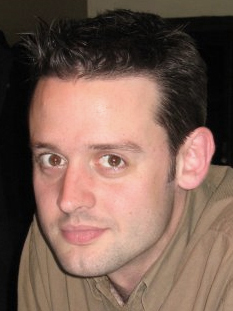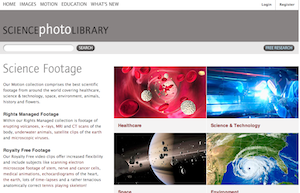Footage News Exclusive:
Here is the first in a series of interviews by Footage News we’re calling ‘Getting-To-Know-The-Library’ – more to follow!


Name: Ben Jones
Position: Head of Motion
Stock footage Agency: Science Photo Library
Explain Science Photo Library in a sentence:
We collate and create unique, accurate and informative clips about the world around us, the processes that shape it, and the research that reveals how it works.
Q. When did you decide to start offering stock footage?
Around the start of 2007, although it had long been discussed.
Q. Why?
Around that time, the move to digital workflows within the industry made it more accessible to us, as it obviated the need for us to handle tape and film. On top of that, around the same time, devices and technologies were emerging that allowed our existing still image client base to utilise video in their new products, which meant that we had a developing market that knew us and would find uses for our clips. Taken together, they made a compelling case for taking the plunge.
Q. Which stock footage subjects are you offering now?
We divide the collection into seven broad subject areas: Science & Technology, Health & Medicine, Environment, Space & Spaceflight, Animals, Plants and History.
Each has a dedicated showreel on our home page.
Running through all of those subject categories, though, we specialise in science education, following the curriculum to produce material likely to be of use to publishers of electronic learning resources, and also specialise in using the latest scientific imaging techniques to visualise subjects in a novel way.
Q. All stock – or do you also license editorial and feature video?
We do licence clips taken from TV shows etc, but we licence it all as stock clips.
Q. Have you needed to employ new staff to cater for the footage/video market?
Yes, we have employed two dedicated video editors to create and manage the video workflow, as well as creating my role to manage it all. Much of the sales and back-office work has been undertaken by the existing stills staff, who are kept up to date with the demands and complexities of the new product.
Q. What in your view is the largest hurdle when starting to offer footage stock?
Putting the technological infrastructure in place for the video archive was a serious task – we’d been amassing footage for less than a year when we overtook the storage requirements of the 26-year-old stills library, for instance. With that in place, the biggest ongoing task is marketing it to the new clients – the stock footage industry is quite different to the one we knew in stills.
Q. Is there a standard industry pricing structure for editorial and creative stock?
Similar distinctions apply as with stills, with pricing tiers for RM, RF, micro and subscription, and mixed in with that sites that allow contributors to set their own prices, and then there’s per clip versus per second billing on top of that. There are broad groupings by industry that have developed, for instance in TV production rates, where things are more mature and seem more stable, but plenty of agencies are trying different things in different sectors all the time.
Q. Where do your requests come from? individual researchers, production companies?
Production companies generally seem to hire freelance researchers for a specific project, and then the researcher moves on to the next company and project. Many of the requests come from these researchers. With other clients, for instance publishing, it’s more likely to be permanent in-house research staff. And as well as those, there are always the random ones that come out of the blue.
Q. Which are the most regular video formats requested for license?
HD footage is the most popular, even for people not making HD programmes. We do downsize to PAL or NTSC for some clients. We send everything out with Photo JPEG compression, which seems universally accepted.
Q. How do you ensure your footage is credited?
It’s a condition of the terms & conditions, although in practice it’s hard to enforce, especially for TV uses.
Q. How do you currently deliver licensed footage?
Mostly by FTP, but if it’s a large order we can send discs or even drives. More recently we have developed an e-commerce platform and the ability for registered clients to download directly from our website.
Q. Are any of your stills contributors supplying footage?
Yes, a lot of them were producing footage and animations long before we supplied it. Some contributors have moved into footage with the arrival of cameras like the Canon 5d MkII, which shoots fine video and stills.
Q. Which footage subjects are you looking to increase content in?
Science education and specialist imaging are our big target areas.
Q. What was your best seller this month (MAY)?
Our best deal so far this month has been for three medical scans: this brain ,this heart and this chest
Q. Any exclusive stock?
More than half of our clips are exclusive, and a good amount of them are wholly-owned, including the brain and heart above. We’ve shot chemistry experiments, biology demonstrations, hospitals, doctors and nurses, and created animations in healthcare, chemistry, biology, physics, astrophysics and astronomy… it didn’t look like there was anyone out there making it for stock, so we had to take matters into our own hands!
Q. Whats new at SPL?
We get amazing new footage in constantly: we’ve recently taken on an authoritative weather collection, mathematical modelling, some incredible electron microscope movies, the start of an encyclopaedic collection of cell biology animations and we’ve just completed a shoot filming human parasites at the London School of Hygiene and Tropical Medicine. Away from the footage, there’s been a promising start since last year’s launch of our e-commerce-enabled website, which has seen some good uses already. Internally, we’ve been streamlining our workflow and processes to speed up the delivery of clips to clients and agents, which is less glitzy but just as important.
– ENDS –
Thanks for your time on this Ben!

Pingback: Interview: Ben Jones, Head of Motion – Science Photo Library | Photo Archive News
Pingback: Interview: Ben Jones, Head of Motion – Science Photo Library |